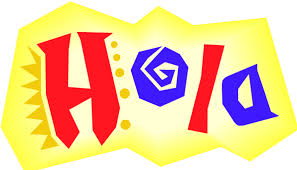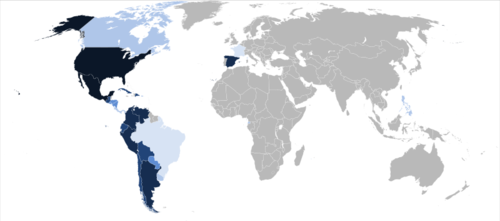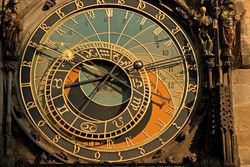Difference between revisions of "Category:Spanish language"
Jump to navigation
Jump to search
(→1990s) |
|||
| (64 intermediate revisions by the same user not shown) | |||
| Line 1: | Line 1: | ||
{| style="margin-top:10px; background:none;" | |||
| style="background:white; width:65%; border:1px solid #a7d7f9; vertical-align:top; color:#000; padding: 5px 10px 10px 8px; -moz-border-radius: 10px; -webkit-border-radius: 10px; border-radius:10px;" | | |||
<!-- ===================== COLONNA DI SINISTRA ==================== --> | |||
{| cellpadding="2" cellspacing="5" style="width:100%; vertical-align:top; background:transparent;" | |||
{{WindowMain | |||
|title= Spanish language (Home Page) | |||
|backgroundLogo= Bluebg_rounded_croped.png | |||
|logo= history.png | |||
|px= 38 | |||
|content= [[File:Spanish language.jpg|500px]] | |||
'''Spanish''' is a Romance language, and the official state language in [[Spain]], and in most of South and Central America. It is written in a variant of the Latin alphabet. | |||
'''Spanish''' is the primary language of Scholarship and Fiction used since the 16th century in [[Spain]] and large parts of South and Central America. | |||
Latin (in the past) and English (in recent times) have been the international languages more commonly used by Spanish and Latino American scholars in addition to Spanish. | |||
* See [http://en.wikipedia.org/wiki/Spanish_language Wikipedia] | |||
[[File:Spanish language Map.png|500px]] | |||
}} | |||
==== | {{WindowMain | ||
[[ | |title= [[Spanish]] : [[Spanish Scholars|Scholars]], [[Spanish Authors|Authors]], & [[Spanish Artists|Artists]] | ||
|backgroundLogo= Bluebg_rounded_croped.png | |||
|logo= Spanish flag.png | |||
|px= 38 | |||
|content= | |||
}} | |||
{{WindowMain | |||
|title= [[Argentine]] : [[Argentine Scholars|Scholars]], [[Argentine Authors|Authors]], & [[Argentine Artists|Artists]] | |||
|backgroundLogo= Bluebg_rounded_croped.png | |||
|logo= Argentine flag.png | |||
|px= 38 | |||
|content= | |||
}} | |||
{{WindowMain | |||
|title= [[Bolivian]] : [[Bolivian Scholars|Scholars]], [[Bolivian Authors|Authors]], & [[Bolivian Artists|Artists]] | |||
|backgroundLogo= Bluebg_rounded_croped.png | |||
|logo= Bolivian flag.png | |||
|px= 38 | |||
|content= | |||
}} | |||
{{WindowMain | |||
|title= [[Chilean]] : [[Chilean Scholars|Scholars]], [[Chilean Authors|Authors]], & [[Chilean Artists|Artists]] | |||
|backgroundLogo= Bluebg_rounded_croped.png | |||
|logo= Chilean flag.png | |||
|px= 38 | |||
|content= | |||
}} | |||
{{WindowMain | |||
|title= [[Colombian]] : [[Colombian Scholars|Scholars]], [[Colombian Authors|Authors]], & [[Colombian Artists|Artists]] | |||
|backgroundLogo= Bluebg_rounded_croped.png | |||
|logo= Columbian flag.png | |||
|px= 38 | |||
|content= | |||
}} | |||
{{WindowMain | |||
|title= [[Mexican]] : [[Mexican Scholars|Scholars]], [[Mexican Authors|Authors]], & [[Mexican Artists|Artists]] | |||
|backgroundLogo= Bluebg_rounded_croped.png | |||
|logo= Mexican flag.png | |||
|px= 38 | |||
|content= | |||
}} | |||
{{WindowMain | |||
|title= [[Peruvian]] : [[Peruvian Scholars|Scholars]], [[Peruvian Authors|Authors]], & [[Peruvian Artists|Artists]] | |||
|backgroundLogo= Bluebg_rounded_croped.png | |||
|logo= Peruvian flag.png | |||
|px= 38 | |||
|content= | |||
}} | |||
{{WindowMain | |||
|title= [[Uruguayan]] : [[Uruguayan Scholars|Scholars]], [[Uruguayan Authors|Authors]], & [[Uruguayan Artists|Artists]] | |||
|backgroundLogo= Bluebg_rounded_croped.png | |||
|logo= Uruguayan flag.png | |||
|px= 38 | |||
|content= | |||
}} | |||
== | {{WindowMain | ||
= | |title= [[Fields of Research]] | ||
|backgroundLogo= Bluebg_rounded_croped.png | |||
|logo= contents.png | |||
|px= 38 | |||
|content= [[File:Fields research.jpg|thumb|250px]] | |||
'''''[[Spanish language]]''''' : [[:Category:Second Temple Studies--Spanish|Second Temple Studies]] -/- [[:Category:Apocalyptic Studies--Spanish|Apocalyptic Studies]] -- [[:Category:Archaeology--Spanish|Archaeology]] -- [[:Category:Bible Studies--Spanish|Bible Studies]] -- [[:Category:Christian Origins Studies--Spanish|Christian Origins Studies]] -- [[:Category:Early Christian Studies--Spanish|Early Christian Studies]] -- [[:Category:Early Islamic Studies--Spanish|Early Islamic Studies]] -- [[:Category:Early Jewish Studies--Spanish|Early Jewish Studies]] -- [[:Category:Early Samaritan Studies--Spanish|Early Samaritan Studies]] -- [[:Category:Enochic Studies--Spanish|Enochic Studies]] -- [[:Category:Gospels Studies--Spanish|Gospels Studies]] -- [[:Category:Hebrew Bible Studies--Spanish|Hebrew Bible Studies]] -- [[:Category:Hellenistic-Jewish Studies--Spanish|Hellenistic-Jewish Studies]] -- [[:Category:Historical Jesus Studies--Spanish|Historical Jesus Studies]] -- [[:Category:Johannine Studies--Spanish|Johannine Studies]] -- [[:Category:Josephus Studies--Spanish|Josephus Studies]] -- [[:Category:New Testament Studies--Spanish|New Testament Studies]] -- [[:Category:NT Apocrypha Studies--Spanish|NT Apocrypha Studies]] -- [[:Category:Qumran Studies--Spanish|Qumran Studies]] -- [[:Category:OT Apocrypha Studies--Spanish|OT Apocrypha Studies]] -- [[:Category:OT Pseudepigrapha Studies--Spanish|OT Pseudepigrapha Studies]] -- [[:Category:Pauline Studies--Spanish|Pauline Studies]] -- [[:Category:Petrine Studies--Spanish|Petrine Studies]] -- [[:Category:Philo Studies--Spanish|Philo Studies]] -- [[:Category:Reception History--Spanish|Reception History]] -- [[:Category:Septuagint Studies--Spanish|Septuagint Studies]] -- [[:Category:Wisdom Studies--Spanish|Wisdom Studies]] -- [[:Category:Women's Studies--Spanish|Women's Studies]] -/- [[:Category:Fiction--Spanish|Fiction]] -- [[:Category:Varia--Spanish|Varia]] | |||
}} | |||
==== | |} | ||
|<!-- SPAZI TRA LE COLONNE --> style="border:5px solid transparent;" | | |||
<!-- ===================== COLONNA DI DESTRA ==================== --> | |||
| style="width:35%; border:1px solid #a7d7f9; background:#f5faff; vertical-align:top; padding: 5px 10px 10px 8px; -moz-border-radius: 10px; -webkit-border-radius: 10px; border-radius:10px;"| | |||
{| id="mp-right" cellpadding="2" cellspacing="5" style="width:100%; vertical-align:top; background:#f5faff; background:transparent;" | |||
{{WindowMain | |||
|title= [[Languages]] | |||
|backgroundLogo= Bluebg_rounded_croped.png | |||
|logo= contents.png | |||
|px= 38 | |||
|content= [[File:Languages.jpg|thumb|left|250px]] | |||
[[English language|English]] -- [[French language|French]] -- [[German language|German]] -- [[Italian language|Italian]] -- [[Spanish language|Spanish]] -//- [[Afrikaans language|Afrikaans]] -- [[Albanian language|Albanian]] -- [[Arabic language|Arabic]] -- [[Armenian language|Armenian]] -- [[Bulgarian language|Bulgarian]] -- [[Catalan language|Catalan]] -- [[Chinese language|Chinese]] -- [[Croatian language|Croatian]] -- [[Czech language|Czech]] -- [[Danish language|Danish]] -- [[Dutch language|Dutch]] -- [[Estonian language|Estonian]] -- [[Farsi language|Farsi]] -- [[Finnish language|Finnish]] -- [[Flemish language|Flemish]] -- [[Greek language|Greek]] -- [[Hebrew language|Hebrew]] -- [[Hungarian language|Hungarian]] -- [[Icelandic language|Icelandic]] -- [[Japanese language|Japanese]] -- [[Korean language|Korean]] -- [[Latin language|Latin]] -- [[Latvian language|Latvian]] -- [[Lithuanian language|Lithuanian]] -- [[Maltese language|Maltese]] -- [[Norwegian language|Norwegian]] -- [[Polish language|Polish]] -- [[Portuguese language|Portuguese]] -- [[Romanian language|Romanian]] -- [[Russian language|Russian]] -- [[Serbian language|Serbian]] -- [[Slovak language|Slovak]] -- [[Slovenian language|Slovenian]] -- [[Swedish language|Swedish]] -- [[Ukrainian language|Ukrainian]] -- [[Welsh language|Welsh]] -- [[Yiddish language|Yiddish]] | |||
}} | |||
{{WindowMain | |||
= | |title= [[Timeline]] ([[Spanish language|Spanish]]) | ||
|backgroundLogo= Bluebg_rounded_croped.png | |||
|logo= contents.png | |||
|px= 38 | |||
|content= [[File:Timeline.jpg|thumb|left|250px]] | |||
'''''[[Spanish language]]''''' : [[:Category:Spanish language--2020s|2020s]] -- [[:Category:Spanish language--2010s|2010s]] -- [[:Category:Spanish language--2000s|2000s]] -- [[:Category:Spanish language--1990s|1990s]] -- [[:Category:Spanish language--1980s|1980s]] -- [[:Category:Spanish language--1970s|1970s]] -- [[:Category:Spanish language--1960s|1960s]] -- [[:Category:Spanish language--1950s|1950s]] -- [[:Category:Spanish language--1940s|1940s]] -- [[:Category:Spanish language--1930s|1930s]] -- [[:Category:Spanish language--1920s|1920s]] -- [[:Category:Spanish language--1910s|1910s]] -- [[:Category:Spanish language--1900s|1900s]] -- [[:Category:Spanish language--1850s|1850s]] -- [[:Category:Spanish language--1800s|1800s]] -- [[:Category:Spanish language--1700s|1700s]] -- [[:Category:Spanish language--1600s|1600s]] -- [[:Category:Spanish language--1500s|1500s]] -- [[:Category:Spanish language--1450s|1450s]] -- [[Spanish language|Home]] | |||
'''''[[Timeline]]''''' : [[2020s]] -- [[2010s]] -- [[2000s]] -- [[1990s]] -- [[1980s]] -- [[1970s]] -- [[1960s]] -- [[1950s]] -- [[1940s]] -- [[1930s]] -- [[1920s]] -- [[1910s]] -- [[1900s]] -- [[1850s]] -- [[1800s]] -- [[1700s]] -- [[1600s]] -- [[1500s]] -- [[1450s]] -- [[Medieval]] -- [[Timeline|Home]] | |||
}} | |||
{{WindowMain | |||
|title= [[Translated from Spanish]] | |||
|backgroundLogo= Bluebg_rounded_croped.png | |||
|logo= history.png | |||
|px= 38 | |||
|content= [[File:Translate.jpg|thumb|left|250px]] | |||
}} | |||
|} | |||
|} | |||
Spanish | |||
Latest revision as of 20:37, 30 December 2019
Pages in category "Spanish language"
The following 105 pages are in this category, out of 105 total.
'
- Spanish language (1500s)
- Spanish language (1600s)
- Spanish language (1700s)
- Spanish language (1800s)
- Spanish language (1850s)
- Spanish language (1900s)
- Spanish language (1910s)
- Spanish language (1920s)
- Spanish language (1930s)
- Spanish language (1940s)
- Spanish language (1950s)
- Spanish language (1960s)
- Spanish language (1970s)
- Spanish language (1980s)
- Spanish language (1990s)
- Spanish language (2000s)
- Spanish language (2010s)
*
1
- Resurrección de Jesús y misterio pascual (1973 Léon-Dufour), book (Spanish ed.)
- El fundador del cristianismo (1974 Dodd / Lator), book (Spanish ed.)
- Las Parábolas del reino (1974 Dodd / de la Fuente), book (Spanish ed.)
- El Nuevo Testamento y la historia del cristianismo primitivo (1975 Bornkamm / Leita), book (Spanish ed.)
- Ensayos exegéticos (1978 Käsemann), book (Spanish ed.)
- El evangelio según Juan (1979-1999 Brown), book (Spanish ed.
- Sociología del movimiento de Jesús (1979 Theissen), book (Spanish ed.)
- Jesús y el Espíritu (1981 Dunn / Fernández/Talavero), book (Spanish ed.)
- Seguimiento y carisma (1981 Hengel), book (Spanish ed.)
- Abba: El mensaje central del Nuevo Testamento (1981 Jeremias / Ortiz/Vevia/Ruiz-Garrido/Bernáldez/Rey/Martínez), book (Spanish ed.)
- Los evangelios gnósticos (1982 Pagels), book (Spanish ed.)
- ¿Cómo entendió y vivió Jesús su muerte (1982 Schürmann / Martínez), book (Spanish ed.)
- Estudios sobre el Nuevo Testamento (1983 Bornkamm / Sauras/Martínez), book (Spanish ed.)
- Historia política de Israel: desde los orígenes a Alejandro Magno (1984 Cazelles / Sierra), book (Spanish ed.)
- Sacerdotes antiguos, Sacerdote nuevo: según el Nuevo Testamento (1984 Vanhoye), book (Spanish ed.)
- Estudios de sociología del cristianismo primitivo (1985 Theissen), book (Spanish ed.)
- El evangelio según Lucas (1986-2005 Fitzmyer / Mínguez), book (Spanish ed.)
- El evangelio según Marcos (1986-1987 Gnilka), book (Spanish ed.)
- Del movimiento de Jesús a la Iglesia cristiana (1987 Aguirre Monasterio), book
- Ética del Nuevo Testamento (1987 Schrage), book (Spanish ed.)
- El Targum de Isaías: la versión aramea del profeta Isaías (1988 Ribera Florit), book
- El mensaje moral del Nuevo Testamento (1988-1989 Schnackenburg), book (Spanish ed.)
- Muhammad: su vida, basada en las fuentes más antiguas = Muhammad: His Life Based on the Earliest Sources (1989 Lings / Algora), book (Spanish ed.)
- Lectura del evangelio de Juan (1989-1998 Léon-Dufour / Ortiz), book (Spanish ed.)
- La sinagoga cristiana (1989 Montserrat Torrents), book
- El evangelio: Unidad y pluralismo (1989 Pikaza), book
- Evangelio y tradición de Israel (1991 Collin/Lenhardt), book (Spanish ed.)
- Conflicto en Lucas: Jesús, autoridades, discípulos = Conflict in Luke: Jesus, Authorities, Disciples (1992 Kingsbury / Godoy), book (Spanish ed.)
- El Evangelio según San Mateo (1993-2006 Luz / Olasagasti), book (Spanish ed.)
- El Nuevo Testamento en su entorno social (1993 Stambaugh/Balch), book (Spanish ed.)
- La mesa compartida: Estudios del Nuevo Testamento desde las ciencias sociales (1994 Aguirre Monasterio), book
- El cristianismo, una religión judía (1995 Flusser / Kowarik), book (Spanish ed.)
- La fiesta judía de las Cabañas (Sukkot): interpretaciones midrásicas en la Biblia y en el judaísmo antiguo (1995 Rafael), book
- Orígenes del cristianismo (1995 Trevijano Etcheverría), book
- El judeo-cristianismo palestino en el siglo I (1995 Vidal Manzanares), book
- Cuando las mujeres eran sacerdotes (1996 Torjesen / Valiente), book (Spanish ed.)
- Raíces bíblicas de la fe cristiana (1997 Aguirre Monasterio), book
- En el crisol de la prueba: Estudio exegético de Sir 2, 1-18 (1997 Calduch-Benages), book
- Cristología del Nuevo Testamento (1997 Cullmann / Pikaza/Gattinoni), book (Spanish ed.)
- Targum Jonatán de los Profetas Posteriores en tradición babilónica: Ezequiel (1997 Ribera Florit), book
- La llama eterna (1997 Ripley / Gallart), novel (Spanish ed.)
- Targum Jonatán de los Profetas Primeros en tradición babilónica, 3: I-II Reyes (1998 Martínez Borobio), book
- Lo hebreo en los autos sacramentales de Calderón (1998 Reyre), book
2
- La religión judía: Historia y Teología (2001 Rodríguez Carmona), book
- Historia social del cristianismo primitivo: Los inicios en el judaísmo y las comunidades cristianas (2001 Stegemann/Stegemann / Montes), book (Spanish ed.)
- La religión de los primeros cristianos (2002 Theissen / Olasagasti), book (Spanish ed.)
- Los valores negados: Ensayo de exégesis socio-científica sobre la autoestigmatización en el movimiento de Jesús (2003 Gil Arbiol), book
- ¿De dónde viene el cristianismo? (2003 Taylor / López), book (Spanish ed.)
- Los tres proyectos de Jesús y el cristianismo naciente (2003 Vidal García), book
- Teología del judeocristianismo (2004 Daniélou), book (Spanish ed.)
- Cristianismos perdidos (2004 Ehrman / Noriega), book (Spanish ed.)
- Filiación: Cultura pagana. Religión de Israel. Orígenes del cristianismo (2005-2012 de Navascués Benlloch/Ayán Calvo/Aroztegui Esnaola/Crespo Losada/Sáez Gutiérrez), edited volume
- La nueva Jersusalén: ¿Ciudad celeste o ciudad terrestre? (2005 Álvarez Valdés), book
- Esplendor en la diáspora: La historia de José (Gn 37-50) y sus relecturas en la literatura bíblica y parabíblica (2006 Guevara Llaguno), book
- Antropología bíblica: Tiempos de gracia (2006 Pikaza), book
- La infancia de Jesús/Jesus' Childhood: Texto bilingüe del Evangelio apócrifo del Pseudo-Tomás/Bilingual Text of the Apocryphal Gospel of Pseudo-Thomas (2009 Aasgaard), book (Spanish ed.)
~
- Alfonso de Palencia (M / Spain, 1423-1492), scholar
- Maria de Agreda (F / Spain, 1602-1665), visionary
- Ramón Franquelo (M / Spain, 1824-1874), playwright
- Gregoria Urbina y Miranda
- Félix Azzati (M / Spain, 1874-1929), translator
- Enrique García-Velloso (M / Argentina, 1880-1938), playwright
- Xavier Zubiri (M / Spain, 1898-1983), translator
- Luis Farré (M / Argentina, 1902-1997), scholar
- Alejandro Núñez Alonso (M / Spain, 1905-1982), novelist
- José Díaz Morales (b.1908), film director
- Emma Susana Speratti Piñero (F / Argentina, 1919-1990), author
- Luis Heriberto Rivas (M / Argentina, 1937), scholar
- Germán Espinosa (1938-2007), novelist
- Andreas Faber-Kaiser (M / Spain, 1944-1994), arch-fi author
- Gabriel Marcelo Nápole (1957-), scholar
- Luis Humberto Crosthwaite (b.1962), novelist
- Juan Tafur (b.1970), novelist
- Luis Berninsone
- Francisco Jiménez Bedman, scholar
- José Pablo Martín, scholar
- Julio Trebolle Barrera, scholar
- José María Triviño, scholar





